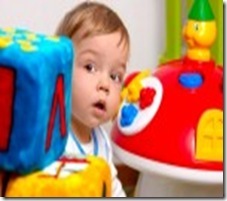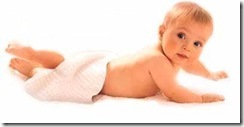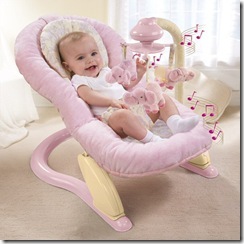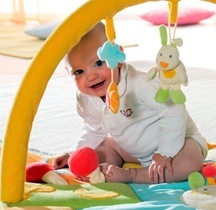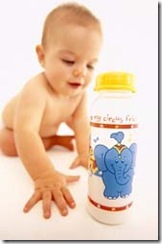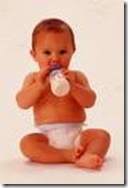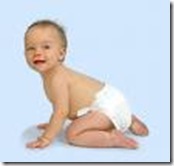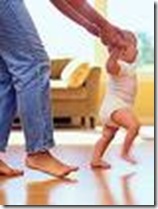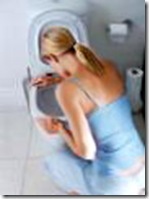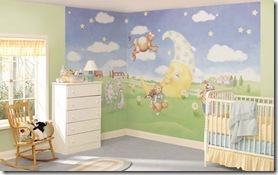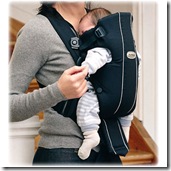Month 1
Most babies are able to . . .
-
Lift head briefly when on stomach
-
Startle at loud noise
-
Blink at bright lights
-
Stare and focus at faces
-
Hold up head at 45 degree angle
Month 2
Most babies are able to . . .
-
Smile in response to your smile
-
Make noises other than crying
-
Hold up head at 45 degree angle while on stomach
-
Make smoother movements
-
Hold head steady when upright
-
Raise chest and head while on stomach
-
Bring both hands together
-
Bear weight on legs
Month 3
Most babies are able to . . .
-
Hold up head at 45 degree angle while on stomach
-
Hold head steady when upright
-
Laugh and smile
-
Recognize your face
-
Kick legs
-
Recognize your voice
-
Hold up head at 90 degree angle while on stomach
-
Bring both hands together
-
Squeal and coo in delight
-
Do small mini pushups
-
Bear weight on both legs
-
Bat at toys
-
Reach for toys and objects
-
Turn to familiar voices
-
Make a razzing sound
Month 4
Most babies are able to . . .
-
Hold up head at 90 degree angle while on stomach
-
Bear weight on both legs
-
Coo when you talk
-
Laugh and smile
-
Grasp a rattle or toy
-
Pay attention to small object held in front of his or her face
-
Roll over
-
Reach out for objects
-
Do small mini push ups
-
Turn in direction of familiar voices
-
Hold head level with body when pulled to sit
Month 5
Most babies are able to . . .
-
Roll over
-
Pay attention to small objects held in front of his or her face
-
Reach out for objects
-
Grasp a rattle or toy
-
Hold head level with body when pulled to sit
-
Make sounds
-
Turn to new sounds
-
Recognize own name
-
Get upset if you take a toy away
-
Pass object from one hand to the other
-
Try to get toy or object that is out of reach
-
Sit momentarily without support
-
Repeat sounds like mama or dada
Month 6
Most babies are able to . . .
-
Keep head level when pulled to sitting position
-
Sit momentarily with minimal support
-
Roll back and forth in both directions
-
Imitate sound and facial expressions
-
Sit without support
-
Feed itself a biscuit or bottle
-
Get upset if you take a toy away
-
Pull up to standing position from sitting
-
Work at getting a toy that is out of reach
-
Start crawling
-
Get into a sitting position from stomach
-
Say mama or dada
-
Pick up small objects with fingers
-
Babble and combine two syllable sounds
-
Separation and stranger anxiety may begin
Month 7
Most babies are able to . . .
-
Sit without support
-
Work at getting a toy that is out of reach
-
Feed itself
-
Start crawling or lunging forward
-
Get upset if you take a toy away
-
Play peek-a-boo
-
Distinguish emotions by your tone of voice
-
Pass object from one hand to the other
-
Separation and stranger anxiety may begin
-
Stand while holding onto something
-
Wave goodbye
-
Clap hands
-
Bang objects together
-
Say mama or dada
-
Pull up to standing position from sitting
-
Walk holding onto furniture
Month 8
Most babies are able to . . .
-
Start crawling
-
Pass object from one hand to the other
-
Respond to own name
-
Mouth and chew on objects
-
Reach for spoon when being fed
-
Turn away when finished eating
-
Say mama and dada
-
Stand while holding on to something
-
Crawl well
-
Pull up to standing position from sitting
-
Walk holding onto furniture
-
Clap and bang objects together
-
Separation and stranger anxiety may begin
-
Indicate wants with different gestures
-
Use thumb and finger pincer grasp to pick things up
-
Stand alone momentarily
-
Wave goodbye
Month 9
Most babies are able to . . .
-
Stand while holding on to something
-
Look for dropped objects
-
Pull up to standing position from sitting
-
Clap and bang objects together
-
Combine syllables into word like sounds
-
Separation and stranger anxiety may begin
-
Use thumb and finger pincer grasp to pick things up
-
Walk holding onto furniture
-
Stand alone momentarily
-
Wave goodbye
-
Drop object and then looks for them
-
Understand the word no
-
Begin to identify self in a mirror
-
Say mama and dada to the right parents
-
Play patty cake
-
Play ball
-
Drink from a cup independently
-
Stand alone well
-
Say one word other than mama or dada
Month 10
Most babies are able to . . .
-
Stand holding on to someone or something
-
Walk holding onto furniture
-
Pull up to standing position from sitting
-
Crawl well
-
Use thumb and finger pincer grasp to pick things up
-
Say mama and dada to the right parents
-
Understand the word no but doesn’t always obey it
-
Respond to own name
-
Indicate what he or she wants with gestures other than crying
-
Stand alone momentarily
-
Drink from a cup independently
-
Stand alone well
-
Play ball and patty cake
-
Walk for a step or two
-
Say one word other than mama or dada
-
Put toys or object into a container
Month 11
Most babies are able to . . .
-
Say mama and dada to the right parents
-
Wave goodbye
-
Clap hands
-
Understand the word no but doesn’t always obey it
-
Stand alone momentarily
-
Play ball and patty cake
-
Say one word other than mama or dada
-
Drink from a cup independently
-
Indicate what he or she wants with gestures other than crying
-
Imitate others
-
Put toys or object into a container
-
Stand alone well
-
Babble that sounds like her or she is talking a foreign language
-
Say two or more words other than mama or dada
-
Drink from a cup independently
-
Understand simple instructions
-
Walk well
Month 12
Most babies are able to . . .
-
Imitate others sounds and activities
-
Babble different word like sounds
-
Clap hands and bang objects together
-
Say one word other than mama or dada
-
Crawl well
-
Walk holding onto furniture well
-
Fearful of strangers
-
Pull off socks
-
Say two or more words other than mama or dada
-
Take a few steps
-
Understand simple instructions
-
Test parents responses to certain behavior
-
Stand well
-
Walk with help
-
Shake head no
-
Walk well
-
Scribble on paper or anything else they can get their hands on
-
Say three or more words other than mama or dada
-
Respond to command
-
Babble that sounds like her or she is talking a foreign language
-
Drink from a cup independently
